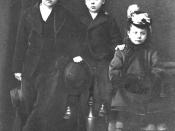Abstract
Everyone has a birth order, and it is easy to observe and talk about. Birth order is the order in which a child is born into his or her family. Many other influences or factors also contribute to a person's intelligence and achievement. Some factors that may affect birth order are sex of siblings, time between births, and absence of a parent. Regardless, as human beings we are left with the question. Why are we the way we are? Many insightful social scientists have studied birth order for over 100 years; Alfred Alder was the first to study the influences of birth order. Alder's theory has left psychology with the building blocks to answer the question of whom we are. Depending on the order in which a person is born into a family, the only child, firstborn, second born, last-born, it will help decide which characteristic that person may hold.
Everyone has wondered at one time or another, "How can siblings be so different?" Maybe the older sibling acts like the dictator of the family, or the younger sibling is always striving to be the center of attention. What if the order in which the children were born was switched, or changed, would the children in the family be different? The answer is: most likely. Birth order is one of many elements that affect who we are and how we relate to others. Birth order is the order in which a child is born into a family. It is usually established by age two for most children and usually does not change once it is established. Birth order results from coping with a life situation, along with programming by parents. In larger families, birth order tends to repeat itself back to the first born with four or more children.



WOW!
Just wanted to say this is a great essay. The content and citations were very helpful to me in my own research and essay (On achieving self-identity in adulthood).
0 out of 0 people found this comment useful.